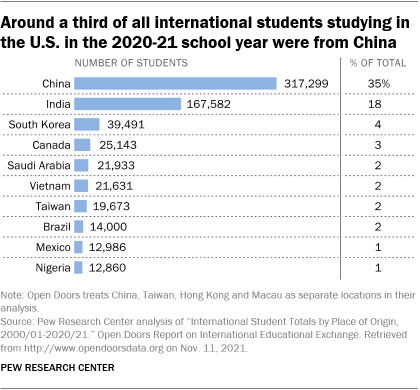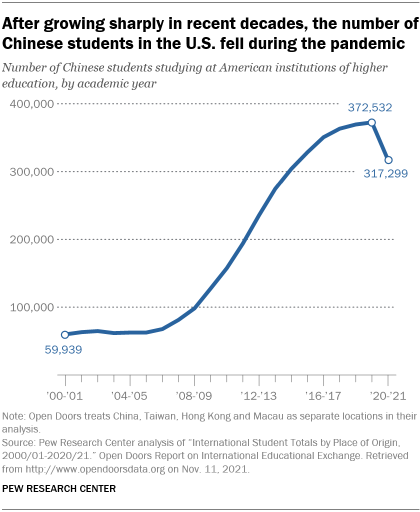American universities are generally held in high esteem around the world, according to a spring Pew Research Center survey in 16 advanced economies. A median of 59% of adults across these societies describe American universities as either the best in the world or above average relative to those in other developed nations.
Even so, the number of foreign students studying in the United States fell sharply during the 2020-21 academic year according to recently released data from the Institute of International Education, likely reflecting the ongoing effects of the coronavirus pandemic.
Fewer than 1 million foreign students enrolled for either online or in-person classes at U.S. universities in the 2020-21 school year, comprising 4.6% of total enrollment at American higher educational institutions. That not only marks a 15% year-over-year decrease from the 2019-20 school year, but also marks the first time since 2014-15 that fewer than a million international students have enrolled at U.S. institutions.
This Pew Research Center analysis examines international students studying in the United States. The analysis is based on the following data from the Institute of International Education (IIE): “International Student Totals by Place of Origin, 2000/01-2020/21.” Past Center reporting has relied on data from Immigration and Customs Enforcement based on data received from Freedom of Information Act (FOIA) requests.
This analysis also draws on survey data from 17 advanced economies. In the U.S., we surveyed 2,596 adults from Feb. 1 to 7, 2021. Everyone who took part in the U.S. survey is a member of the Center’s American Trends Panel (ATP), an online survey panel that is recruited through national, random sampling of residential addresses. This way nearly all adults have a chance of selection. The survey is weighted to be representative of the U.S. adult population by gender, race, ethnicity, partisan affiliation, education and other categories.
For non-U.S. data, this post draws on nationally representative surveys of 16,254 adults from March 12 to May 26, 2021, in 16 advanced economies. All surveys were conducted over the phone with adults in Canada, Belgium, France, Germany, Greece, Italy, the Netherlands, Spain, Sweden, the United Kingdom, Australia, Japan, New Zealand, Singapore, South Korea and Taiwan.
This study was conducted in places where nationally representative telephone surveys are feasible. Due to the coronavirus outbreak, face-to-face interviewing is not currently possible in many parts of the world.
Here are the questions used for this analysis, along with responses. Visit our methodology database for more information about the survey methods outside the U.S. For respondents in the U.S., read more about the ATP’s methodology.
China remained the leading place of origin for international students, with 35% of all international students in the 2020-21 school year hailing from the country. The second most common place of origin was India (18%), followed by South Korea (4%) and Canada (3%). Some of these countries also experienced the largest year-over-year decreases in the number of students who enrolled at U.S. institutions. The largest such percentage decreases occurred in South Korea (-21%), China (-15%) and India (-13%).
The overall decrease in the number of foreign students in the U.S. in 2020-21 was driven by sizable reductions in first-time students coming from abroad – in many cases due to border closings, flight cancellations or other challenges caused by the COVID-19 pandemic.
Even before pandemic, increase in Chinese students had slowed
While the number of Chinese students studying in the U.S. fell sharply in the 2020-21 school year, their growth rate had slowed dramatically even before the pandemic. The slowdown followed years of sharp growth.
Though the exact reasons for the slowdown in Chinese students are unclear, some may find the U.S. a less desirable place to study abroad. Some observers, including the president of Columbia University, have raised concerns that tense bilateral relations between the U.S. and China are damaging American universities’ ability to attract top academic talent, particularly from China. Still others have pointed to policies put in place during the Trump administration to restrict Chinese students studying in certain fields or even revoke their visas.
Chinese students paid an estimated $15 billion in tuition at U.S. colleges in the 2018-19 year. Still, the American public is open to limiting their presence in U.S. academia. A majority of Americans (55%) support limiting Chinese students studying in the U.S., even as a broad majority (80%) say it’s good for U.S. colleges and universities to accept international students in general, according to a February Pew Research Center survey.
Only around a third (31%) of Americans under the age of 30 support limiting Chinese students in the U.S., but the share rises to around half (49%) among those ages 30 to 49 and to around seven-in-ten (69%) of those 50 and older.
There are also differences in views by Americans’ educational attainment. A 59% majority of those without a college degree support limiting Chinese students, while those with a college degree are about evenly split: 47% favor limiting Chinese students in the U.S. and 52% oppose the idea.
Partisan differences are pronounced, too. A majority of Republicans and independents who lean toward the Republican Party (69%) support limiting Chinese students while 56% of Democrats and Democratic leaners are opposed.
Note: Here are the questions used for this analysis, along with responses. Visit our methodology database for more information about the survey methods outside the U.S. For respondents in the U.S., read more about the ATP’s methodology.






